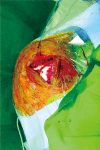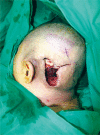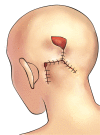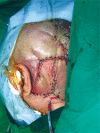Reconstruction of a Complex Scalp Defect after the Failure of Free Flaps: Changing Plans and Strategy
- PMID: 28913317
- PMCID: PMC5556891
- DOI: 10.7181/acfs.2017.18.2.112
Reconstruction of a Complex Scalp Defect after the Failure of Free Flaps: Changing Plans and Strategy
Abstract
The ideal scalp reconstruction involves closure of the defect with similar hair-bearing local tissue in a single step. Various reconstructions can be used including primary closure, secondary healing, skin grafts, local flaps, and microvascular tissue transfer. A 53-year-old female patient suffered glioblastoma, which had recurred for the second time. The neurosurgeons performed radial debridement and an additional resection of the tumor, followed by reconstruction using a serratus anterior muscle flap with a split-thickness skin graft. Unfortunately, the flap became completely useless and a bilateral rotation flap was used to cover the defect. Two month later, seroma with infection was found due to recurrence of the tumor. Additional surgery was performed using multiple perforator based island flap. The patient was discharged two weeks after surgery without any complications, but two months later, the patient died. Radical surgical resection of tumor is the most important curative option, followed by functional and aesthetic reconstruction. We describe a patient with a highly malignant tumor that required multiple resections and subsequent reconstruction. Repeated recurrences of the tumor led to the failure of reconstruction and our strategy inevitably changed, from reconstruction to palliative treatment involving fast and stable wound closure for the patient's comfort.
Keywords: Perforator flap; Reconstructive surgical procedures; Scalp; Surgical flaps.
Conflict of interest statement
No potential conflict of interest relevant to this article was reported.
Figures








References
-
- Sittitavornwong S, Morlandt AB. Reconstruction of the scalp, calvarium, and frontal sinus. Oral Maxillofac Surg Clin North Am. 2013;25:105–129. - PubMed
-
- Frodel JL, Jr, Ahlstrom K. Reconstruction of complex scalp defects: the “Banana Peel” revisited. Arch Facial Plast Surg. 2004;6:54–60. - PubMed
-
- Gundeslioglu AO, Selimoglu MN, Doldurucu T, Bekerecioglu M. Reconstruction of large anterior scalp defects using advancement flaps. J Craniofac Surg. 2012;23:1766–1769. - PubMed
-
- Hoffman JF. Management of scalp defects. Otolaryngol Clin North Am. 2001;34:571–582. - PubMed
-
- Lesavoy MA, Dubrow TJ, Schwartz RJ, Wackym PA, Eisenhauer DM, McGuire M. Management of large scalp defects with local pedicle flaps. Plast Reconstr Surg. 1993;91:783–790. - PubMed
LinkOut - more resources
Full Text Sources
Other Literature Sources

